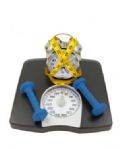|
Clean, get up, jerk, snatch—if you know, you know. The kettlebell has established its status as an essential tool over the years and exercisers love the small piece of equipment for its versatility. Although it looks more like a cannonball, the kettlebell is one piece of strength training equipment every exerciser should get to know. A popular strength training tool in Russia since the 1800's, kettlebells have only more recently become a staple in American gyms. But what's so special about kettlebells compared to other strength equipment? According to an eight-week experiment by the American Council on Exercise, kettlebell training not only increased strength, but also aerobic capacity, dynamic balance and core strength in participants—it's the total package when it comes to fitness. Where to BeginKettlebells can be a safe tool for strength training, but only if you're using the appropriate amount of weight and proper form. Injury commonly occurs with exercises that are too advanced or when you're using too much weight and performing the move incorrectly. Physical therapist Leada Malek says she has seen a lot of injuries—particularly in the shoulders, back and hips—that could have been prevented with proper technique. Ideally, you will get instruction from a professional before trying new exercises on your own, but if that isn't an option, Malek suggests keeping these three things in mind: 1. Start with a weight you're able to control with one arm. "For example, if you can do a bicep curl with a 10-pound dumbbell, chances are you'll be able to swing that upwards with core and glute control," she explains. "Better to start with a lighter weight than too heavy, but know that you'll need a bit heavier weight for the ballistic swing moves." Those swing moves (such as the kettlebell swing) are more advanced and come with a higher degree of risk if performed incorrectly. 2. Start with grind movements. "There are two kinds of movements in kettlebell workouts: grind movements and ballistic exercises," she describes. "Grind movements are like other basic strength exercises, and should be mastered before trying the ballistic movements. These include stiff and bent-knee deadlifts, squats, overhead presses and pushups. They serve as the foundation for ballistic movements. Ballistic moves require more of a thrust at the hip and 'catch' at the top of the movement where the kettlebell should almost feel weightless. For example, one-arm swings, one-arm pulls, high pull, cleans and snatches. These power moves require proper core and hip strength to control and move at the base, [while staying] stable through the movement." 3. Start simple and light. When you're ready to find out what the hype is all about, check out some of the basic kettlebell workouts on YouTube. Use a mirror to be sure you're doing the exercises with proper form. As you become stronger and more comfortable, you can progress to more advanced movements. "Most females can start with a 10-pound kettlebell because they are likely able to use that for movements that are pretty basic," says Malek. "Most men can start with 15 pounds for exercises that don't require overhead movement and 20 pounds for beginner overhead movements. In general, more complex exercises require more demanding positions with less stability, so it's better to start with a lighter weight that can be safely controlled overhead." She explains that these amounts of weight can be tested by doing a standing shoulder press. If all feels well and proper form is maintained, you can transition into more complex moves with that weight. A Basic Routine for BeginnersCertified kettlebell instructor Daniel Rosenthal offers this basic circuit using just one kettlebell to his clients. Do one to three sets of each exercise with eight to 12 repetitions per set.
|






